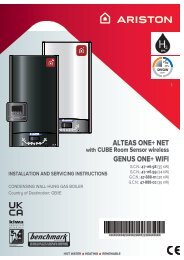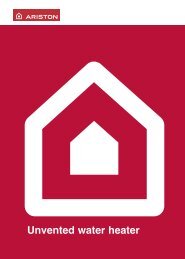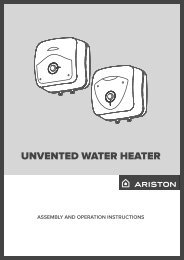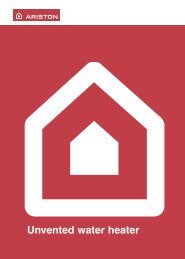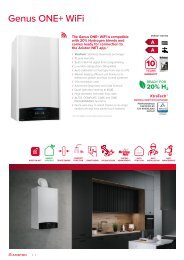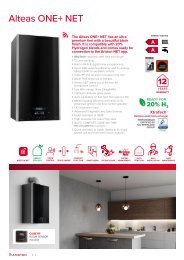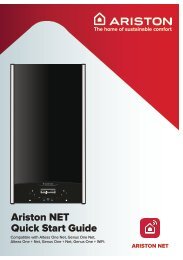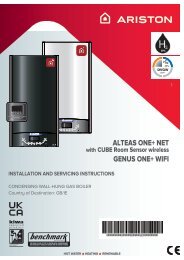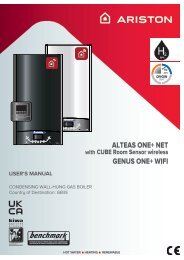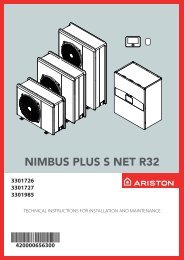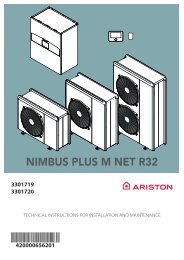Nimbus Compact M NET R32 Installation Manual UK
Create successful ePaper yourself
Turn your PDF publications into a flip-book with our unique Google optimized e-Paper software.
Hydraulic connections<br />
4.1.6 Characteristics of the supply water<br />
Make sure that the system is supplied with water having a<br />
hardness between 4.5°dH (8°fH) and 8.4°dH (15°fH) and conductivity<br />
below 500μS/cm.<br />
In zones where the water is particularly hard, mount a water<br />
softener.<br />
If the system is filled with water that is aggressive (the pH<br />
should be maintained between 7.5 and 9), ferruginous or hard,<br />
use treated water to prevent limescale build-up, corrosion and<br />
damages to the appliance. Even a slight quantity of impurities<br />
in the water may decrease system performance.<br />
The filling water used must strictly be treated in the case of<br />
high-capacity installations (high volumes of water) or if frequent<br />
water top-ups are required to maintain a constant level<br />
of liquid in the system. If the system must be cleaned, fill it<br />
completely with treated water.<br />
Glycol adversely affects the appliance’s performances and we<br />
strongly advise not to use it. If glycol is nonetheless used, ARIS-<br />
TON shall not be held liable for any loss of efficiency of the<br />
system and recommends dosing it properly and performing<br />
maintenance.<br />
4.1.7 Filling the system<br />
During filling, it may not be possible to remove all the air from<br />
the system. The residual air will be removed through the automatic<br />
air relief valves during the initial hours of operation of the<br />
system. If the system’s pressure drops excessively, fill the circuit<br />
with water.<br />
a<br />
a<br />
The installation, initial start up, and configuration<br />
must be carried out in accordance with the<br />
instructions, by qualified and competent installer<br />
only. The manufacturer declines all responsibility<br />
for damages caused to people, animals or<br />
possessions following incorrect installation of<br />
the appliance.<br />
During initial filling of the system, check the outflow<br />
of water from the automatic relief outlet.<br />
The water outflow makes the sealing discs inside<br />
the valve work effectively. We recommend performing<br />
the operation with a cloth to absorb the<br />
excess water.<br />
To speed up filling of the system, the system can be deaerated<br />
manually as follows:<br />
– Mount the pipe (1) supplied on the manual deaerator<br />
outlet.<br />
– Open the manual deaerator (2) and channel the water<br />
towards the outside the machine.<br />
– Deaerate the system for a few minutes until all the air<br />
has been removed from the pipes.<br />
– Close the deaerator.<br />
1-ZONE configuration<br />
a<br />
2<br />
1<br />
Fig. 46<br />
The accumulation of air can cause malfunctions<br />
to the system and damage the components.<br />
Note: during the initial start-up the automatic deaeration<br />
function is activated, which is necessary to ensure the system’s<br />
correct operation. The activation of the automatic deaeration<br />
cycles of the system following the initial start-up can be performed<br />
using the Air-purge function 1.12.0 command.<br />
a<br />
The indoor unit contains a pressure gauge which<br />
can be accessed by the installer during the first<br />
filling phase. The system’s pressure can nonetheless<br />
be read through the system interface (parameter<br />
1.16.7). If the interface is not installed<br />
on the machine, we recommend using an external<br />
pressure gauge to check the pressure and allow<br />
the user to fill the system with water.<br />
Check the water pressure on the pressure gauge regularly and<br />
make sure that the pressure is between 0.05 MPa (0.5 bar) and<br />
0.15 MPa (1.5 bar) when the system is cold.<br />
If the pressure is below the minimum value, it must be increased<br />
through the filling cock.<br />
Close the cock once the average value of 0.12 MPa (1.2 bar) has<br />
been reached.<br />
The minimum pressure of the heating/cooling system is 0.05<br />
MPa (0.5 bar).<br />
The maximum pressure of the heating/cooling system is 0.3<br />
MPa (3 bar).<br />
a<br />
If frequent fillings (once a month or more frequently)<br />
are required for your system, this indicates<br />
a potential problem with the installation<br />
(leaks, expansion vessel problems). Contact your<br />
trusted installer to analyse and solve the problem<br />
quickly, and to prevent damage caused by<br />
corrosion of the components due to excessive<br />
water replacement in the system.<br />
28 / EN







